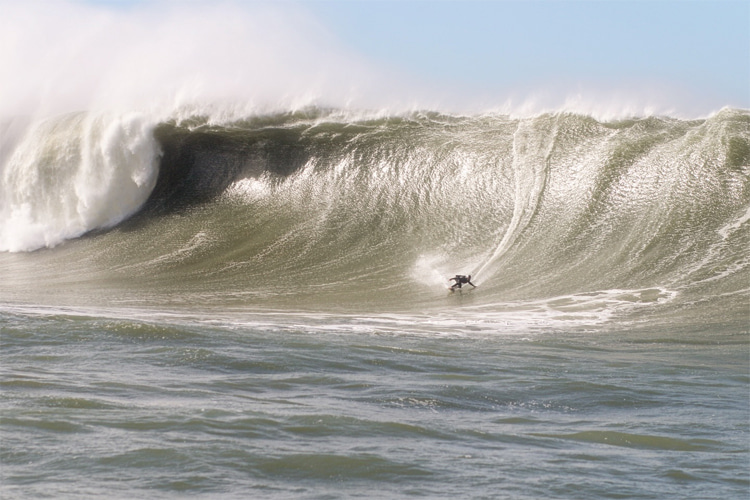
Lucas “Chumbo” Chianca has officially ridden the largest wave ever at Laje da Jaguaruna in Santa Catarina, Brazil. According to the measurement using artificial intelligence technology, the surfer took on a 48.6-foot (14.82-meter) wave.
A massive wall of water rose off the coast of southern Brazil in July, and one of the world’s top big wave surfers was there to greet it.
Chumbo wasn’t even planning to be in Jaguaruna. He was in Bahia when he saw the forecast: a rare, powerful swell fueled by an extratropical cyclone.
The charts were indicating a potentially historic day at Brazil’s very own Nazaré.
So, Lucas dropped everything, drove 22 hours straight back to Rio de Janeiro, and caught a flight south.
Getting to the break itself is an expedition.
Surfers launch from Praia da Jagua and ride jet skis through a punishing stretch of whitewater before reaching the reef, located 3.3 miles (5.3 kilometers) offshore.
Thiago “Jacaré,” a local surfer and founder of Big Waves Brasil, leads many of these missions.
“The window is very tight,” Jacaré explained to Brazilian media.
“You need light winds, good visibility, and you can’t risk fog. If you lose sight of the coastline, you may not make it back.”
Wave of the Day
Conditions that morning were extreme even by big-wave standards.
The cyclone supercharged the Atlantic, stacking up water into enormous peaks over the reef.
But those who know have to go, and Chumbo paddled into position behind the jet ski, rope in hand.
“The unbelievable part is that it was my very first wave of the day,” Chumbo said afterward.
“Dropping down that mountain of water, it felt like an avalanche chasing me. It was special – pure energy.”
Fellow big rider Marco Polo also took advantage of the monster swell, but it was Chumbo’s ride that set a new national record.

AI-Measured Wave Height
Measuring a wave this size isn’t guesswork.
The official number came days later through an innovative system developed by oceanographer Douglas Nemes.
His method uses artificial intelligence (AI) to analyze sequences of photos and video.
By reconstructing the full shape of the wave – from crest to trough – and running several mathematical equations, Nemes produced a scientifically reliable height: 48.6 feet (14.82 meters).
“This is done a hundred times to give me adequate confidence, in a scientific way, to arrive at a reliable value,” he said.
What Makes Jaguaruna So Powerful
The wave that Chumbo rode wasn’t a coincidence. Jaguaruna has been producing giant waves since surfers first explored the reef in 2003.
Known as Laje da Jagua, it is a shallow underwater rock formation about the size of a soccer field.
Depths plunge from around 165 feet (50 meters) to less than 6.5 feet (two meters) in a short distance.
So, when deep-water swells slam into this abrupt rise, the ocean floor forces the waves upward and magnifies them in a process called shoaling.
Tahiti’s Teahupoo has a similar.
But the shape of the reef also creates wave convergence. Energy from the surrounding deep water is funneled into one focused point, stacking the swell even higher.
It’s the same physics that powers Nazaré in Portugal, though the geography is different.
Nazaré has an undersea canyon, while Jaguaruna’s power comes from a shallow plateau surrounded by deeper water.
Its location is also key.
Most of Brazil’s coastline has a wide continental shelf that weakens swells before they reach shore.
But Jaguaruna sits in a spot where southern storm systems deliver raw energy straight onto the reef, before the waves lose strength.
A Spot with a Historic Track Record of Danger
Before surfers discovered it, the Laje was infamous for a darker reason.
The reef sits on an old shipping route and was long known as a ship graveyard.
Historians count more than 70 shipwrecks near the site, including one in 1839 involving Italian revolutionary Giuseppe Garibaldi.
The dangers were so notorious that the Santa Marta Lighthouse was built in 1891 to help ships avoid the reef.
For surfers, though, that same hazard has become a natural wonder.
Since its first documented sessions in the early 2000s, Laje da Jagua has grown into Brazil’s premier big-wave arena, alongside the infamous Avalanche.
Pioneers like Zeca Scheffer and Rodrigo Resende opened the door, and contests in the 2000s helped establish its reputation.
Now, with Chumbo’s record-breaking ride, Jaguaruna is pushing harder than ever for official recognition as the “Capital of Brazil’s Biggest Wave.”
Will the place become an international phenomenon like Nazaré’s Praia do Norte?
Words by Luís MP | Founder of SurferToday.com


Leave a Reply